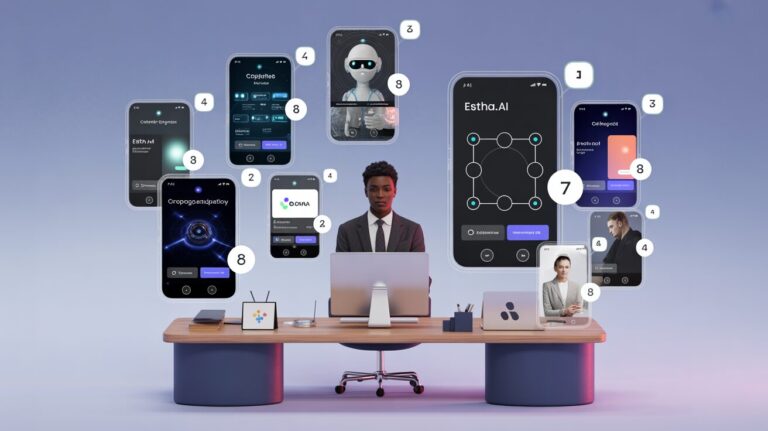Table Of Contents
- Introduction
- Understanding APIs in the No-Code AI Ecosystem
- REST APIs: The Traditional Approach
- GraphQL APIs: The Modern Contender
- Practical Comparison: REST vs GraphQL in No-Code AI Scenarios
- Choosing the Right API Approach for Your AI Applications
- How Estha Simplifies API Integration in No-Code AI Development
- Future Trends in API Integration for No-Code AI
- Conclusion
REST vs GraphQL APIs in No-Code AI: Which Integration Method Is Right For Your AI Applications?
In today’s rapidly evolving digital landscape, the ability to create powerful AI applications without writing code has democratized technology development. At the heart of these no-code AI platforms lies a critical but often overlooked component: APIs (Application Programming Interfaces). These invisible bridges connect your AI applications with data sources, external services, and other systems, ultimately determining how efficiently your AI solution can communicate with the digital world.
For anyone building AI applications on no-code platforms, understanding the distinction between REST and GraphQL APIs isn’t just technical jargon—it’s a decision that can significantly impact your application’s performance, flexibility, and user experience. Whether you’re a content creator looking to enhance your website with an AI chatbot, an educator building interactive learning tools, or a business owner developing a customer service AI solution, the API approach you choose matters.
In this comprehensive guide, we’ll demystify REST and GraphQL APIs in the context of no-code AI development. We’ll explore their fundamental differences, practical applications, and most importantly, help you determine which integration method aligns best with your specific AI application needs. By the end of this article, you’ll have the knowledge to make informed decisions about API integration—without needing to write a single line of code.
REST vs GraphQL APIs for No-Code AI
Choosing the right integration method for your AI applications
Building AI applications without code? Your choice of API integration affects performance, flexibility, and user experience.
REST APIs
Advantages:
- Simplicity – Intuitive, familiar patterns
- Universal support – Works with almost everything
- Caching – Better for static content
- Statelessness – Reliable in variable conditions
Limitations:
- Over/under-fetching of data
- Multiple requests for complex data
- Versioning challenges
- Limited real-time capabilities
GraphQL APIs
Advantages:
- Precise data retrieval – Get exactly what you need
- Single request efficiency – Complex data in one call
- Self-documenting – Clear schema definition
- Real-time support – Built-in subscription capabilities
Limitations:
- Steeper learning curve
- More complex caching implementation
- Potential performance issues with complex queries
- Less universal support than REST
When to Choose Each API Type
Choose REST when:
- Your AI app has simple, predictable data needs
- You’re integrating with many traditional services
- Caching is critical for performance
- You need maximum compatibility
Choose GraphQL when:
- Your AI needs complex, nested data
- You want to minimize network requests
- Real-time updates are important
- Your data requirements change frequently
Estha Makes API Integration Simple
Estha’s no-code AI platform abstracts away API complexity through an intuitive drag-drop-link interface, letting you focus on creating powerful AI experiences without technical overhead.
For more details on REST vs GraphQL APIs for no-code AI applications, read the full article above.
Understanding APIs in the No-Code AI Ecosystem
Before diving into the REST vs GraphQL comparison, it’s essential to understand what APIs actually do in the context of no-code AI platforms. Think of APIs as specialized translators that allow different software systems to communicate with each other using standardized rules.
In no-code AI development, APIs serve several critical functions:
- Data retrieval and submission: They enable your AI applications to fetch information from databases or external services and send back user inputs or processing results.
- AI model integration: APIs connect your no-code interface with underlying AI engines, allowing you to leverage sophisticated machine learning capabilities without understanding the complex code behind them.
- Third-party service access: They let your AI applications tap into functionalities from other platforms, such as payment processors, email services, or social media platforms.
- Real-time updates: APIs facilitate the continuous flow of information that keeps AI applications responsive and up-to-date.
When building on a platform like Estha, the API integration approach affects how your AI application communicates with both the platform’s internal AI capabilities and any external services you might connect to. Understanding the strengths and limitations of REST and GraphQL helps you maximize the potential of your no-code AI creation.
REST APIs: The Traditional Approach
REST (Representational State Transfer) APIs have been the industry standard for web services communication for nearly two decades. They operate on a simple principle: resources (data entities) are accessed via standard HTTP methods like GET, POST, PUT, and DELETE.
In a REST architecture, each resource has its own unique URL (endpoint). For example, if your AI application needs customer data, it might make a GET request to an endpoint like /customers/123 to retrieve information about customer #123.
REST APIs are organized around the concept of resources and rely on HTTP status codes (like 200 for success or 404 for not found) to indicate the outcome of operations. They typically return data in JSON or XML format, which your no-code AI application can then process and present to users.
Advantages of REST for No-Code AI
For no-code AI developers, REST APIs offer several compelling benefits:
Simplicity and familiarity: REST follows intuitive patterns that match how the web works, making it easier for beginners to understand. Most no-code platforms have built-in support for common REST operations, allowing you to quickly integrate external data sources.
Extensive ecosystem: As the most widely adopted API standard, REST is supported by virtually every web service and third-party platform. This means you’ll rarely encounter compatibility issues when connecting your no-code AI application to external services.
Caching capabilities: REST APIs can leverage HTTP caching, potentially improving performance for AI applications that frequently access the same data. This is particularly valuable for content-focused AI tools that don’t require real-time updates for every interaction.
Statelessness: Each REST request contains all the information needed to complete it, without relying on previous requests. This makes REST APIs reliable even in unstable network conditions, which can be important for AI applications deployed in various environments.
Limitations of REST in AI Applications
Despite its advantages, REST presents certain challenges in the AI context:
Over-fetching and under-fetching: REST endpoints typically return fixed data structures. This often means your AI application receives either too much data (requiring more processing) or too little (requiring multiple requests), which can impact performance and responsiveness.
Multiple requests for complex data: If your AI application needs information from several related resources, REST usually requires multiple separate requests. For instance, retrieving a user profile with their posts, comments, and preferences might need 4-5 different API calls.
Versioning complexity: As AI applications evolve, managing changes to REST API structures can become challenging, potentially requiring you to maintain multiple API versions or risk breaking existing functionality.
Limited real-time capabilities: Traditional REST doesn’t inherently support real-time updates, which can be crucial for dynamic AI applications that need to reflect immediate changes.
GraphQL APIs: The Modern Contender
Developed by Facebook in 2015 and later open-sourced, GraphQL represents a fundamentally different approach to API design. Rather than organizing around fixed resource endpoints, GraphQL provides a single endpoint where clients can specify exactly what data they need using a query language that resembles JSON.
With GraphQL, your no-code AI application sends a query that precisely describes the data structure it requires. The server then responds with exactly that structure—no more, no less. This shifts control of data retrieval from the server to the client (your AI application).
For example, instead of making multiple REST calls to different endpoints, a GraphQL query might look like:
{ user(id: "123") { name email preferences { theme notifications } recentActivity { date action } } }This single query retrieves precisely the user data the AI application needs, structured exactly as requested.
Advantages of GraphQL for No-Code AI
GraphQL offers several distinct advantages for no-code AI development:
Precise data retrieval: By allowing your AI application to request exactly what it needs, GraphQL eliminates over-fetching and under-fetching problems. This can significantly improve performance, especially for AI applications with complex data requirements.
Single request for complex data: Instead of making multiple API calls to assemble a complete data set, GraphQL enables your AI application to retrieve all necessary information in a single request. This reduces network overhead and simplifies your application logic.
Strongly typed schema: GraphQL APIs have a well-defined schema that clearly documents all available data and operations. This self-documenting nature makes it easier to understand what data is available to your AI application and how to access it.
Versioning flexibility: GraphQL allows adding new fields and types without impacting existing queries, making it easier to evolve your AI application over time without breaking changes. This is particularly valuable as AI capabilities expand and requirements evolve.
Real-time capabilities: GraphQL supports subscriptions, a feature that enables real-time updates when data changes. This can be crucial for interactive AI applications that need to reflect the latest information without constant polling.
Limitations of GraphQL in AI Applications
Despite its advantages, GraphQL presents certain challenges:
Increased complexity: The flexibility of GraphQL comes with a steeper learning curve. For those new to API concepts, understanding GraphQL’s query language and schema definition can be more challenging than grasping REST basics.
Caching challenges: The flexible nature of GraphQL queries makes HTTP-level caching less straightforward than with REST. While there are caching solutions for GraphQL, they often require additional configuration.
Potential for performance issues: Without proper constraints, clients could request extremely nested or complex data structures that might overload your server. This requires implementing query complexity analysis and limitations.
Less universal support: While GraphQL adoption is growing rapidly, it still doesn’t have the same level of universal support as REST. Some services or platforms your AI application might need to integrate with may not offer GraphQL interfaces.
Practical Comparison: REST vs GraphQL in No-Code AI Scenarios
To better understand which API approach might work best for your no-code AI applications, let’s examine how REST and GraphQL perform in common AI development scenarios:
Scenario 1: Building an AI Chatbot for Customer Support
With REST APIs, your chatbot might need to make separate calls to:
- Fetch customer information
- Retrieve order history
- Check product inventory
- Access knowledge base articles
Each interaction could require multiple API calls, potentially creating latency that affects the user experience.
With GraphQL, your chatbot could make a single query that retrieves all relevant customer, order, product, and knowledge base information based on the conversation context. This could result in more responsive interactions and smoother conversation flows.
Scenario 2: Creating an AI-Powered Content Recommendation Engine
Using REST, your recommendation engine might need to:
- Make one call to get user preferences
- Make another call to get content categories
- Make multiple calls to retrieve content details for each recommended item
With GraphQL, a single query could fetch user preferences along with just the relevant fields for recommended content items (title, thumbnail, duration, etc.) in one request. This efficiency becomes increasingly important as your AI needs to process more data to make better recommendations.
Scenario 3: Developing an AI Health Monitoring Application
In a REST implementation, your health app might need frequent polling of multiple endpoints to check for new readings from different devices or sensors. Each device type might have its own endpoint and data structure.
With GraphQL, you could use subscriptions to receive real-time updates when new health data is available, and your queries could adapt to request only the specific health metrics relevant to each user’s conditions. This creates a more responsive experience while potentially reducing bandwidth usage.
Choosing the Right API Approach for Your AI Applications
When deciding between REST and GraphQL for your no-code AI application, consider these key factors:
Data complexity: If your AI application needs to combine data from multiple sources or requires very specific subsets of information, GraphQL’s precise querying capabilities may provide significant advantages.
Development experience: For those entirely new to API concepts, REST’s simplicity might offer an easier entry point, while those comfortable with more complex data relationships might benefit from GraphQL’s flexibility.
Real-time requirements: If your AI application needs instant updates (like live chat, notifications, or monitoring), GraphQL’s subscription feature provides built-in support for real-time functionality.
Integration needs: Consider what external services your AI application will connect with. If you’re primarily integrating with older or more traditional systems, REST might offer better compatibility.
Performance priorities: If minimizing network requests and data transfer is critical for your AI application’s performance, GraphQL’s ability to fetch multiple resources in a single request could be decisive.
Future flexibility: If you anticipate your AI application evolving significantly over time with changing data requirements, GraphQL’s schema evolution capabilities might provide valuable long-term flexibility.
How Estha Simplifies API Integration in No-Code AI Development
One of the core advantages of building AI applications with Estha is that much of the API complexity is abstracted away through its intuitive drag-drop-link interface. This means you can create sophisticated AI applications without directly managing API calls.
Estha’s platform handles many of the technical challenges of both REST and GraphQL integration behind the scenes, allowing you to focus on what your AI application does rather than how it communicates with various services. Through visual components and connectors, you can:
Access data from multiple sources: Estha provides pre-built connectors to common data sources and services, handling the API communication details automatically.
Combine information efficiently: The platform optimizes data retrieval behind the scenes, applying principles similar to GraphQL’s efficiency even when connecting to traditional REST services.
Build real-time capabilities: Estha includes components for creating responsive, real-time AI applications without having to implement complex subscription mechanisms yourself.
Extend your AI applications: When you need to connect to custom or specialized services, Estha offers flexible integration options that work with both REST and GraphQL APIs.
This abstraction is particularly valuable for non-technical creators who want to build powerful AI applications without getting lost in API implementation details. By handling these complexities within the platform, Estha enables you to create sophisticated AI solutions in minutes rather than weeks or months.
Future Trends in API Integration for No-Code AI
As no-code AI development continues to evolve, we’re seeing several emerging trends in API integration that will shape the landscape:
Hybrid approaches: Many platforms are adopting hybrid approaches that combine the simplicity of REST with the efficiency of GraphQL. This gives no-code developers the best of both worlds without requiring extensive technical knowledge.
AI-enhanced API integration: Increasingly, platforms are using AI itself to simplify API integration, automatically mapping data fields and suggesting optimal connection patterns based on your application needs.
Specialized AI APIs: The rise of purpose-built APIs for specific AI functions (like natural language processing, image recognition, or sentiment analysis) is making it easier to incorporate advanced AI capabilities without understanding the underlying complexity.
Edge computing integration: As AI processing moves closer to end users through edge computing, APIs are evolving to support more distributed architectures, allowing no-code AI applications to operate effectively even with limited connectivity.
Enhanced security patterns: With increasing concerns about data privacy and security, API integration in no-code platforms is incorporating more sophisticated authentication and authorization mechanisms by default.
These trends point toward a future where the technical distinctions between REST and GraphQL become less relevant to no-code developers, as platforms like Estha continue to abstract away implementation details while providing the benefits of modern API approaches.
Conclusion
The choice between REST and GraphQL for your no-code AI applications isn’t about which technology is objectively better—it’s about which approach best serves your specific needs. REST offers simplicity, widespread support, and familiarity, making it accessible for many straightforward AI applications. GraphQL provides precision, efficiency, and flexibility that can be transformative for more complex or data-intensive AI scenarios.
Fortunately, modern no-code AI platforms like Estha are increasingly designed to shield you from the underlying complexities of API integration, allowing you to focus on creating valuable AI experiences rather than wrestling with technical implementation details. By understanding the basic principles and tradeoffs between REST and GraphQL, you can make more informed decisions about your AI application architecture while letting the platform handle the heavy lifting.
As AI technology continues to evolve and become more accessible, the ability to efficiently connect and communicate with diverse data sources and services will remain crucial. Whether through REST, GraphQL, or emerging hybrid approaches, the future of no-code AI development promises even greater capabilities with less technical overhead.
The most important takeaway is that with platforms like Estha, you don’t need to be a technical expert to create sophisticated AI applications that leverage the best of modern API technologies. The power to build intelligent, responsive, and data-rich AI experiences is now accessible to creators from all backgrounds—no coding required.
Ready to Build Your Custom AI Application?
Create personalized AI solutions in minutes without coding or technical knowledge. Estha’s intuitive platform makes it easy to bring your AI vision to life.



